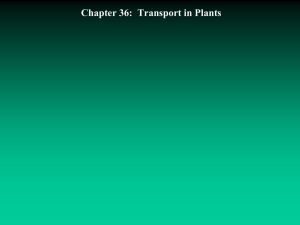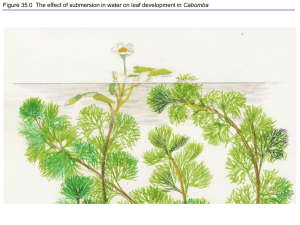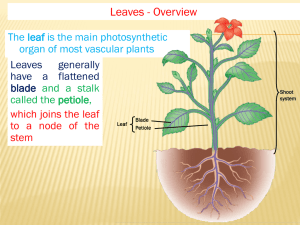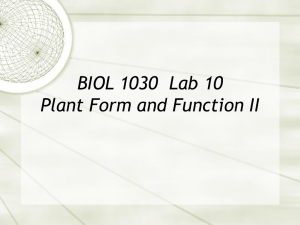Number of stomata
advertisement
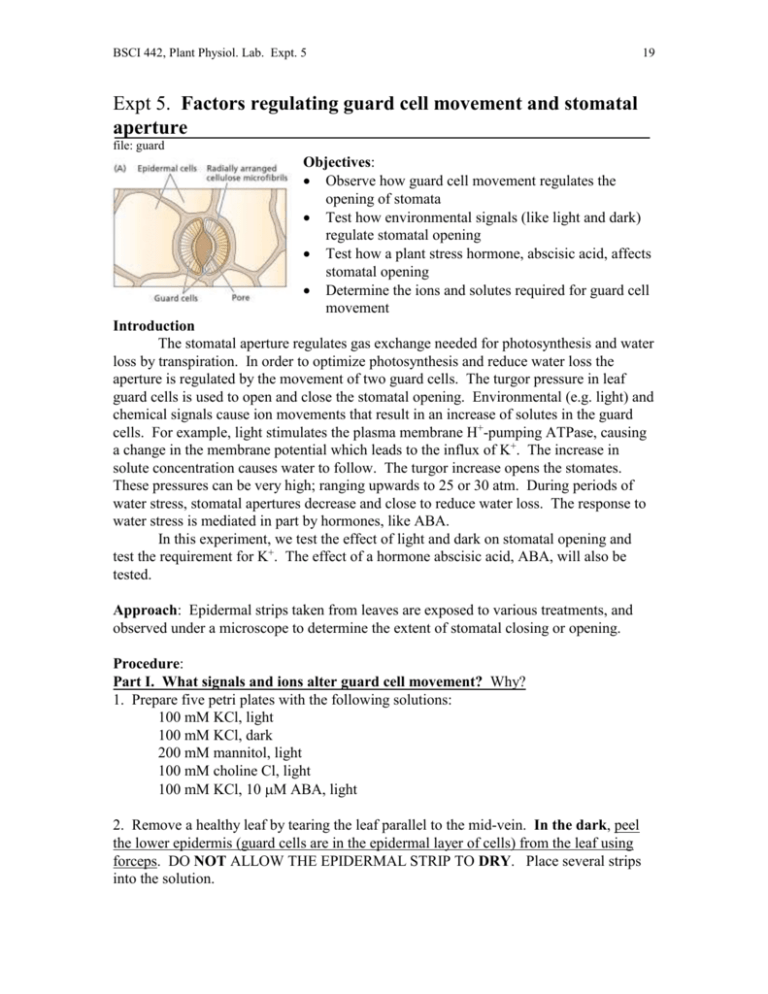
BSCI 442, Plant Physiol. Lab. Expt. 5 19 Expt 5. Factors regulating guard cell movement and stomatal aperture file: guard Objectives: Observe how guard cell movement regulates the opening of stomata Test how environmental signals (like light and dark) regulate stomatal opening Test how a plant stress hormone, abscisic acid, affects stomatal opening Determine the ions and solutes required for guard cell movement Introduction The stomatal aperture regulates gas exchange needed for photosynthesis and water loss by transpiration. In order to optimize photosynthesis and reduce water loss the aperture is regulated by the movement of two guard cells. The turgor pressure in leaf guard cells is used to open and close the stomatal opening. Environmental (e.g. light) and chemical signals cause ion movements that result in an increase of solutes in the guard cells. For example, light stimulates the plasma membrane H+-pumping ATPase, causing a change in the membrane potential which leads to the influx of K+. The increase in solute concentration causes water to follow. The turgor increase opens the stomates. These pressures can be very high; ranging upwards to 25 or 30 atm. During periods of water stress, stomatal apertures decrease and close to reduce water loss. The response to water stress is mediated in part by hormones, like ABA. In this experiment, we test the effect of light and dark on stomatal opening and test the requirement for K+. The effect of a hormone abscisic acid, ABA, will also be tested. Approach: Epidermal strips taken from leaves are exposed to various treatments, and observed under a microscope to determine the extent of stomatal closing or opening. Procedure: Part I. What signals and ions alter guard cell movement? Why? 1. Prepare five petri plates with the following solutions: 100 mM KCl, light 100 mM KCl, dark 200 mM mannitol, light 100 mM choline Cl, light 100 mM KCl, 10 M ABA, light 2. Remove a healthy leaf by tearing the leaf parallel to the mid-vein. In the dark, peel the lower epidermis (guard cells are in the epidermal layer of cells) from the leaf using forceps. DO NOT ALLOW THE EPIDERMAL STRIP TO DRY. Place several strips into the solution. BSCI 442, Plant Physiol. Lab. Expt. 5 20 3. Place plates in light for 1 hour, except for ‘dark’ treatment – put that one in a drawer. 4. Examine the light and dark treated sections under the microscope. Look for pairs of guard cells in a given area. Examine at least 20 pairs for each treatment. Note the number of stomates that are wide open, open, nearly closed or closed. Present results in a table: Treatment Wide Open Number of stomata Open Nearly closed Closed Dark, KCl Light, KCl Light, Mannitol Light, Choline Cl Light, ABA, KCl Part II. Visualizing K+ in cells: Histochemical Localization of K+ 5. Place the epidermal peel (from 100 mM KCl solu. in light and dark) in a cold 10% solution of sodium cobaltinitrite for 5-10 min. This reagent is used to reveal the levels of K+ in open and closed stomates by converting the soluble ion into an insoluble precipitate. Na3Co(NO2)6 + 2K+ ---> K2Na[Co(NO2)6] + 2Na+ 6. Rinse the stained peel for 2-3 min in cold deionized water and mount the tissue in a drop of 5% glycerine. Observe under a microscope. What do you see? Data Analyses and interpretation: Note your observations and propose a model explaining one or more reasons for what you saw. Include this in your lab report! Questions: i) Under what environmental conditions does ABA level increase in plants? (Hint: see Taiz and Zeiger, Ch. 23) ii) Why would light cause a change in stomatal aperture? Hint- When does a plant sense changes in light and dark in the natural environment? iii). What specific molecular events cause the opening of the stomatal aperture? What specific changes occurred in the guard cells? iv). Why is there a difference in your result when you used mannitol instead of KCl? References: Water potential Guard cell movement ABA and water deficit Taiz and Zeiger, 2002, or 2006. Ch. 3, 4 Taiz and Zeiger, 2002 or 2006 Ch. 18 Taiz and Zeiger, 2002 or 2006. Ch. 23 BSCI 442, Plant Physiol. Lab. Expt. 5 21 not used. 8/02 Part B. Measurement of leaf resistance (or stomatal conductance) to water vapor with a diffusive porometer (taken from I. Forseth) Measure leaf resistance of the transpiration pathway. Test the effect of light and dark on leaf resistance. Leaf resistance of the transpiration pathway is related to the diffusion of water vapor from the substomal cavities through the stomata. High resistance would indicate a low level of diffusion of water vapor or a low stomatal conductance as a result of closed stomata. Low resistance indicates a high rate of diffusion of water vapor or high stomatal conductance as a result of open stomata. A diffusive porometer measures diffusion of water vapor from the substomatal chambers through the stomata of an intact plant. The transient porometer which is one type of diffusive porometer, measures the time taken for a portion of a leaf enclosed in a cuvette to raise the humidity inside the cuvette over a fixed humidity interval. This interval can be converted to resistance by the use of an empirical calibration curve. Calibration involves replacing the leaf in the cuvette with a wet surface (usually water saturated filter paper) covered by a calibration plate with known resistance. Material: The porometer consists of 1) The leaf cuvette which is made up of a Vaisala Humicap capable of responding rapidly to changes in humidity, and two thermisters. One thermister measures the temperature of the cuvette, the other measures leaf temperature. 2) The control console, which consists of a battery, a pump which circulates air through the cuvette, a container filled with dessicant which dries the water vapor from the air in the cuvette, a switch controlling humidity ranges, a timer, and a relative humidity/temperature gauge. 3) A calibration plate. Procedure: 1. Set the porometer function switch to the relative humidity setting (RH), open the cuvette and wave it in the air a few times. This will give you an idea of ambient relative humidity. Based on the reading obtained, select the proper humidity range for your measurements using the relative humidity range switch. 2. Next, you should calibrate the porometer using the calibration plate provided with the instrument. Wet a rectangular piece of filter paper with distilled water to the point of saturation, but not to the point of having water drip from the paper. The paper is placed beneath a layer of tape on one side of the calibration plate which has precisely drilled lines of holes. The number and size of these holes determine their resistance to water vapor diffusion. The cuvette is clamped over these holes, and the temperature of the BSCI 442, Plant Physiol. Lab. Expt. 5 22 cuvette, the temperature of the calibration plate and the time it takes for humidity to change over a certain range is recorded for each series of holes. Plot the data on graph paper. 3. Then measure leaf resistance by clamping the cuvette gently onto the abaxial side of the leaf, for lower leaf resistance. The measurement interval begins when the relative humidity reaches a certain level inside the cuvette. As relative humidity rises within the cuvette, due to transpiration from the leaf, the instrument will start timing at a preset minimum relative humidity. When the relative humidity reaches a specified maximum, the time measurement stops. When this point is reached, the air pump starts which forces air through the dessication column and back to the cuvette, lowering humidity past the lower set point, at which point the pump turns off, and the humidification cycle starts again. As the pump dries the cuvette, the results of this measurement are displayed. In order to allow equilibration between the leaf and the cuvette, measurements should be repeated 3-5 cycles before the cuvette is removed from the leaf. 4. Take a drought stressed plant or a dark treated plant, and measure the leaf resistance as in step 3. Is there a difference between a light- versus dark grown plant? Precautions to observe Avoid breathing directly on the leaf because high CO2 in your breath may close the stomata. Avoid touching or getting any water on the sensor. It is very sensitive to liquids and to oils on your hands. Moisture condensation may occur if you clamp the cuvette onto a leaf without having the pump activated, or if you have too much water on the filter paper used during calibration. The first readings after placing a leaf in the cuvette are often less reliable than succeeding readings. Take several readings from one leaf



